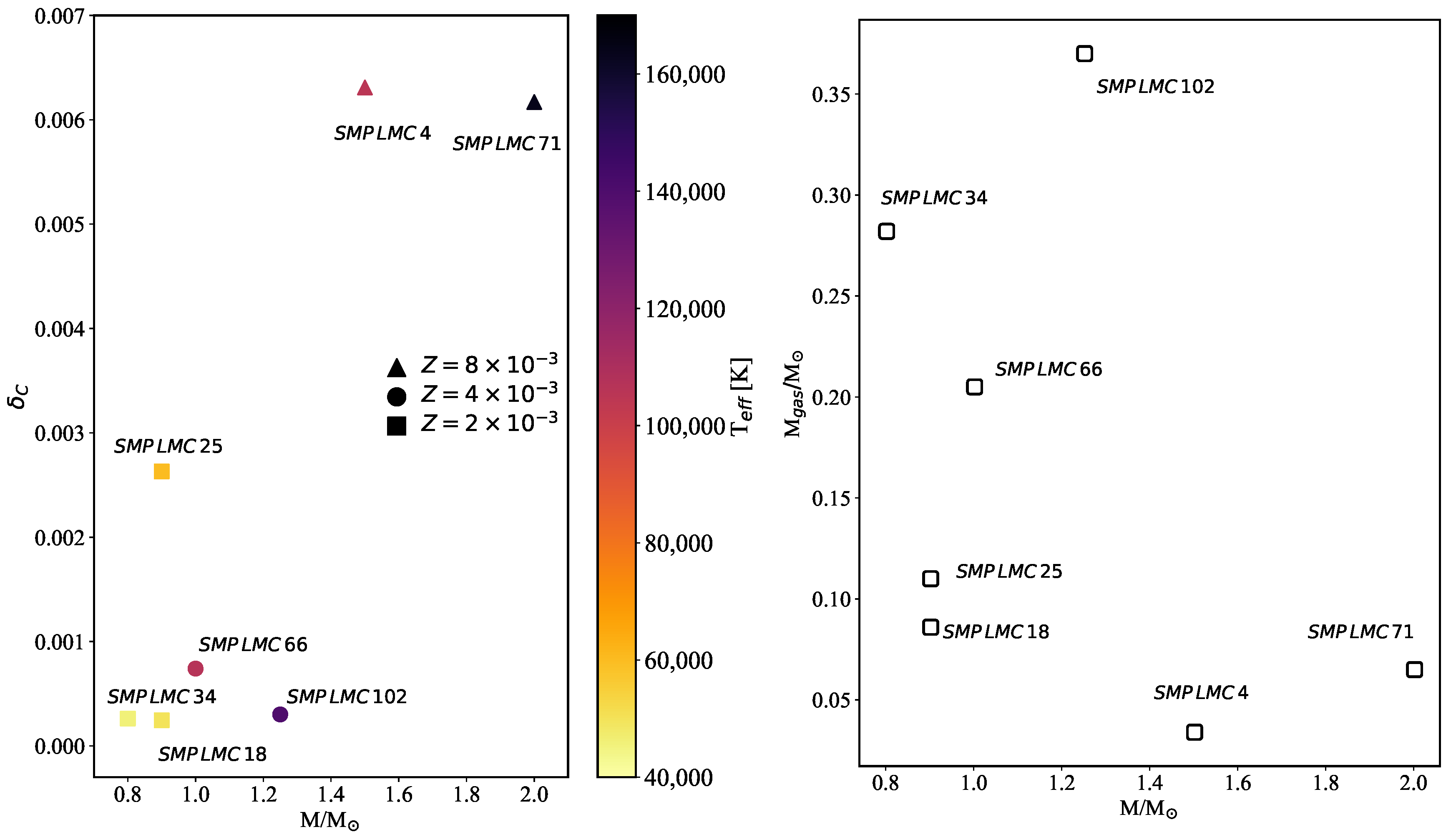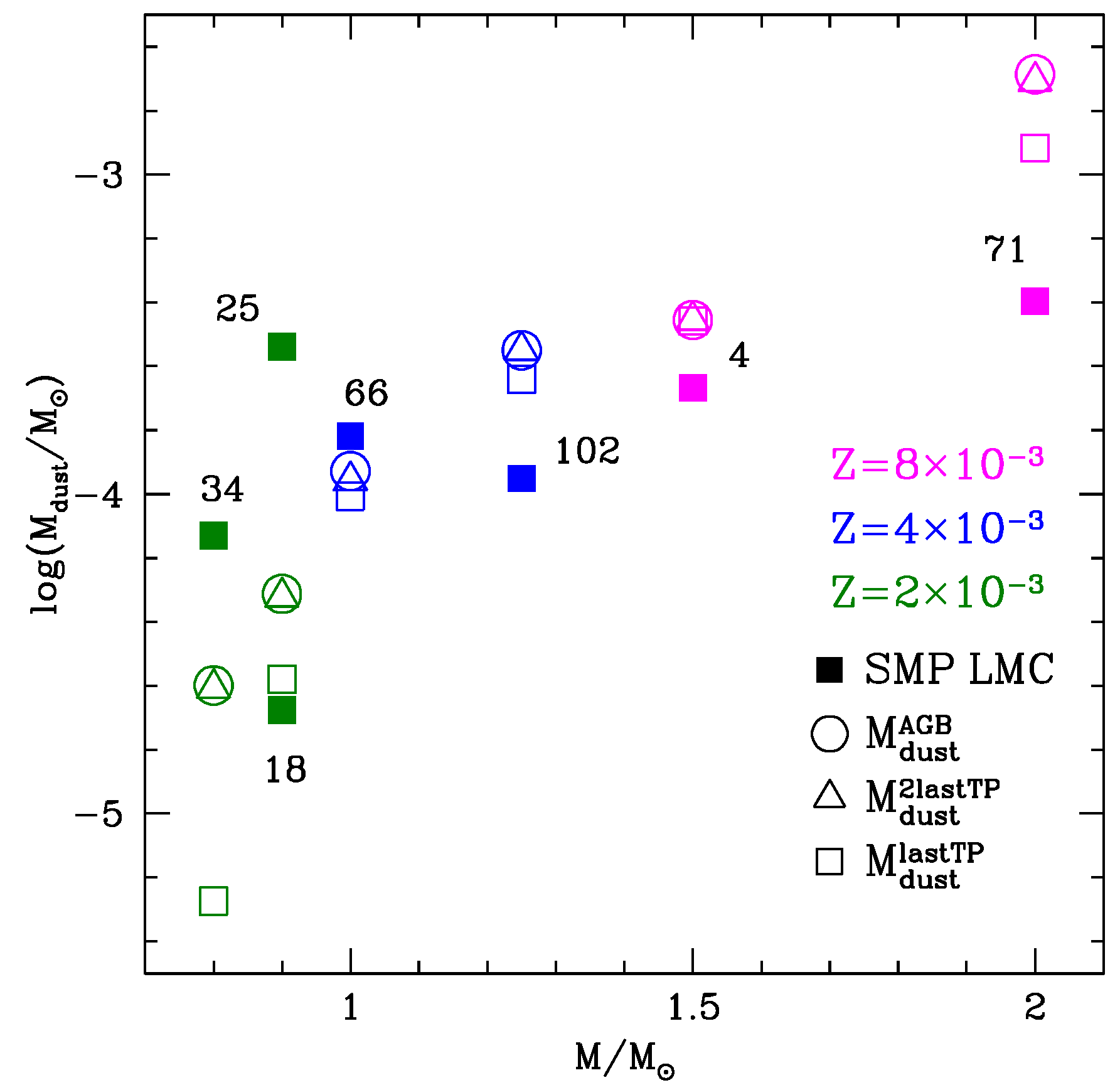Insight on AGB Mass-Loss and Dust Production from PNe
Abstract
1. Introduction
2. Sample and Methodology
3. Discussion
Funding
Data Availability Statement
Acknowledgments
Conflicts of Interest
References
- Karakas, A.I.; Lattanzio, J.C. The Dawes Review 2: Nucleosynthesis and Stellar Yields of Low- and Intermediate-Mass Single Stars. PASA 2014, 31, e030. [Google Scholar] [CrossRef]
- Ventura, P.; Dell’Agli, F.; Tailo, M.; Castellani, M.; Marini, E.; Tosi, S.; Di Criscienzo, M. Nucleosynthesis, Mixing Processes, and Gas Pollution from AGB Stars. Universe 2022, 8, 45. [Google Scholar] [CrossRef]
- Iben, I., Jr. Post main sequence evolution of single stars. Annu. Rev. Astron. Astrophys. 1974, 12, 215–256. [Google Scholar] [CrossRef]
- Sackmann, I.J.; Boothroyd, A.I. The Creation of Superrich Lithium Giants. Astrophys. J. 1992, 392, L71. [Google Scholar] [CrossRef]
- Ventura, P.; Stanghellini, L.; Dell’Agli, F.; García-Hernández, D.A.; Di Criscienzo, M. A test for asymptotic giant branch evolution theories: Planetary nebulae in the Large Magellanic Cloud. Mon. Not. R. Astron. Soc. 2015, 452, 3679–3688. [Google Scholar] [CrossRef][Green Version]
- Ventura, P.; Stanghellini, L.; Di Criscienzo, M.; García-Hernández, D.A.; Dell’Agli, F. Planetary nebulae in the Small Magellanic Cloud. Mon. Not. R. Astron. Soc. 2016, 460, 3940–3949. [Google Scholar] [CrossRef]
- Dell’Agli, F.; Tosi, S.; Kamath, D.; Stanghellini, L.; Bianchi, S.; Ventura, P.; Marini, E.; García-Hernández, D.A. Dust from evolved stars: A pilot analysis of the AGB to PN transition. Mon. Not. R. Astron. Soc. 2023, 526, 5386–5392. [Google Scholar] [CrossRef]
- Tosi, S.; Dell’Agli, F.; Kamath, D.; Stanghellini, L.; Ventura, P.; Bianchi, S.; Gómez-Muñoz, M.A.; García-Hernández, D.A. Planetary nebulae of the Large Magellanic Cloud. I. A multiwavelength analysis. Astron. Astrophys. 2024, 688, A36. [Google Scholar] [CrossRef]
- Ventura, P.; Zeppieri, A.; Mazzitelli, I.; D’Antona, F. Full spectrum of turbulence convective mixing: I. theoretical main sequences and turn-off for 0.6 ÷ 15 M⊙. Astron. Astrophys. 1998, 334, 953–968. [Google Scholar]
- Ventura, P.; di Criscienzo, M.; Schneider, R.; Carini, R.; Valiante, R.; D’Antona, F.; Gallerani, S.; Maiolino, R.; Tornambé, A. The transition from carbon dust to silicate production in low-metallicity asymptotic giant branch and super-asymptotic giant branch stars. Mon. Not. R. Astron. Soc. 2012, 420, 1442–1456. [Google Scholar] [CrossRef][Green Version]
- Ventura, P.; Tosi, S.; García-Hernández, D.A.; Dell’Agli, F.; Kamath, D.; Stanghellini, L.; Bianchi, S.; Tailo, M.; Gómez-Muñoz, M.A. Planetary Nebulae of the Large Magellanic Cloud II: The connection with the progenitors’ properties. Astron. Astrophys. 2024; submitted. [Google Scholar]
- Pietrzyński, G.; Graczyk, D.; Gallenne, A.; Gieren, W.; Thompson, I.B.; Pilecki, B.; Karczmarek, P.; Górski, M.; Suchomska, K.; Taormina, M.; et al. A distance to the Large Magellanic Cloud that is precise to one per cent. Nature 2019, 567, 200–203. [Google Scholar] [CrossRef] [PubMed]
- Shaw, R.A.; Stanghellini, L.; Mutchler, M.; Balick, B.; Blades, J.C. Morphology and Evolution of the Large Magellanic Cloud Planetary Nebulae. Astrophys. J. 2001, 548, 727–748. [Google Scholar] [CrossRef][Green Version]
- Shaw, R.A.; Stanghellini, L.; Villaver, E.; Mutchler, M. Hubble Space Telescope Images of Magellanic Cloud Planetary Nebulae. Astrophys. J. Suppl. Ser. 2006, 167, 201–229. [Google Scholar] [CrossRef]
- Stanghellini, L.; Blades, J.C.; Osmer, S.J.; Barlow, M.J.; Liu, X.W. Hubble Space Telescope Images of Magellanic Cloud Planetary Nebulae: Data and Correlations across Morphological Classes. Astrophys. J. 1999, 510, 687–702. [Google Scholar] [CrossRef][Green Version]
- Stanghellini, L.; Villaver, E.; Manchado, A.; Guerrero, M.A. The Correlations between Planetary Nebula Morphology and Central Star Evolution: Analysis of the Northern Galactic Sample. Astrophys. J. 2002, 576, 285–293. [Google Scholar] [CrossRef]
- Stanghellini, L.; Shaw, R.A.; Gilmore, D. Space Telescope Imaging Spectrograph Ultraviolet Spectra of Large Magellanic Cloud Planetary Nebulae: A Study of Carbon Abundances and Stellar Evolution. Astrophys. J. 2005, 622, 294–318. [Google Scholar] [CrossRef]
- Reid, W.A. A multiwavelength analysis of planetary nebulae in the Large Magellanic Cloud. Mon. Not. R. Astron. Soc. 2014, 438, 2642–2663. [Google Scholar] [CrossRef][Green Version]
- Cutri, R.M.; Wright, E.L.; Conrow, T.; Bauer, J.; Benford, D.; Brandenburg, H.; Dailey, J.; Eisenhardt, P.R.M.; Evans, T.; Fajardo-Acosta, S.; et al. Explanatory Supplement to the WISE All-Sky Data Release Products. Explan. Suppl. Wise-All-Sky Data Release Prod. 2012. [Google Scholar]
- Lasker, B.M.; Lattanzi, M.G.; McLean, B.J.; Bucciarelli, B.; Drimmel, R.; Garcia, J.; Greene, G.; Guglielmetti, F.; Hanley, C.; Hawkins, G.; et al. The Second-Generation Guide Star Catalog: Description and Properties. Astron. J. 2008, 136, 735–766. [Google Scholar] [CrossRef]
- Leisy, P.; Dennefeld, M. Planetary nebulae in the Magellanic Clouds. II. Abundances and element production. Astron. Astrophys. 2006, 456, 451–466. [Google Scholar] [CrossRef][Green Version]
- Henry, R.B.C.; Liebert, J.; Boroson, T.A. Faint Planetary Nebulae in the Magellanic Clouds: Central Star Properties and Nebular Abundances for the Jacoby Sample. Astrophys. J. 1989, 339, 872. [Google Scholar] [CrossRef]
- Ferland, G.J.; Chatzikos, M.; Guzmán, F.; Lykins, M.L.; van Hoof, P.A.M.; Williams, R.J.R.; Abel, N.P.; Badnell, N.R.; Keenan, F.P.; Porter, R.L.; et al. The 2017 Release Cloudy. Rev. Mex. Astron. AstrofíSica 2017, 53, 385–438. [Google Scholar] [CrossRef]
- Stanghellini, L.; García-Lario, P.; García-Hernández, D.A.; Perea-Calderón, J.V.; Davies, J.E.; Manchado, A.; Villaver, E.; Shaw, R.A. Spitzer Infrared Spectrograph Observations of Magellanic Cloud Planetary Nebulae: The Nature of Dust in Low-Metallicity Circumstellar Ejecta. Astrophys. J. 2007, 671, 1669–1684. [Google Scholar] [CrossRef]
- Sloan, G.C.; Lagadec, E.; Zijlstra, A.A.; Kraemer, K.E.; Weis, A.P.; Matsuura, M.; Volk, K.; Peeters, E.; Duley, W.W.; Cami, J.; et al. Carbon-rich Dust Past the Asymptotic Giant Branch: Aliphatics, Aromatics, and Fullerenes in the Magellanic Clouds. Astrophys. J. 2014, 791, 28. [Google Scholar] [CrossRef]
- García-Hernández, D.A.; Villaver, E.; García-Lario, P.; Acosta-Pulido, J.A.; Manchado, A.; Stanghellini, L.; Shaw, R.A.; Cataldo, F. Infrared Study of Fullerene Planetary Nebulae. Astrophys. J. 2012, 760, 107. [Google Scholar] [CrossRef]
- Ferrarotti, A.S.; Gail, H.P. Mineral formation in stellar winds. II. Effects of Mg/Si abundance variations on dust composition in AGB stars. Astron. Astrophys. 2001, 371, 133–151. [Google Scholar] [CrossRef]
- Ventura, P.; Dell’Agli, F.; Schneider, R.; Di Criscienzo, M.; Rossi, C.; La Franca, F.; Gallerani, S.; Valiante, R. Dust from asymptotic giant branch stars: Relevant factors and modelling uncertainties. Mon. Not. R. Astron. Soc. 2014, 439, 977–989. [Google Scholar] [CrossRef]
- Ventura, P.; Karakas, A.; Dell’Agli, F.; García-Hernández, D.A.; Guzman-Ramirez, L. Gas and dust from solar metallicity AGB stars. Mon. Not. R. Astron. Soc. 2018, 475, 2282–2305. [Google Scholar] [CrossRef]
- Dell’Agli, F.; Valiante, R.; Kamath, D.; Ventura, P.; García-Hernández, D.A. AGB dust and gas ejecta in extremely metal-poor environments. Mon. Not. R. Astron. Soc. 2019, 486, 4738–4752. [Google Scholar] [CrossRef]
- Osterbrock, D.E.; Ferland, G.J. Astrophysics of Gaseous Nebulae and Active Galactic Nuclei; University Science Books: Sausalito, CA, USA, 2006. [Google Scholar]
- Natta, A.; Panagia, N. Dust in planetary nebulae. Astrophys. J. 1981, 248, 189–194. [Google Scholar] [CrossRef]
- Otsuka, M.; Ueta, T.; van Hoof, P.A.M.; Sahai, R.; Aleman, I.; Zijlstra, A.A.; Chu, Y.H.; Villaver, E.; Leal-Ferreira, M.L.; Kastner, J.; et al. The Herschel Planetary Nebula Survey (HerPlaNS): A Comprehensive Dusty Photoionization Model of NGC6781. Astrophys. J. Suppl. Ser. 2017, 231, 22. [Google Scholar] [CrossRef] [PubMed]
- Tosi, S.; Dell’Agli, F.; Kamath, D.; Ventura, P.; Van Winckel, H.; Marini, E. Understanding dust production and mass loss in the AGB phase using post-AGB stars in the Magellanic Clouds. Astron. Astrophys. 2022, 668, A22. [Google Scholar] [CrossRef]
- Tosi, S.; Kamath, D.; Dell’Agli, F.; Van Winckel, H.; Ventura, P.; Marchetti, T.; Marini, E.; Tailo, M. A study of carbon-rich post-AGB stars in the Milky Way to understand the production of carbonaceous dust from evolved stars. Astron. Astrophys. 2023, 673, A41. [Google Scholar] [CrossRef]


Disclaimer/Publisher’s Note: The statements, opinions and data contained in all publications are solely those of the individual author(s) and contributor(s) and not of MDPI and/or the editor(s). MDPI and/or the editor(s) disclaim responsibility for any injury to people or property resulting from any ideas, methods, instructions or products referred to in the content. |
© 2024 by the author. Licensee MDPI, Basel, Switzerland. This article is an open access article distributed under the terms and conditions of the Creative Commons Attribution (CC BY) license (https://creativecommons.org/licenses/by/4.0/).
Share and Cite
Tosi, S. Insight on AGB Mass-Loss and Dust Production from PNe. Galaxies 2024, 12, 85. https://doi.org/10.3390/galaxies12060085
Tosi S. Insight on AGB Mass-Loss and Dust Production from PNe. Galaxies. 2024; 12(6):85. https://doi.org/10.3390/galaxies12060085
Chicago/Turabian StyleTosi, Silvia. 2024. "Insight on AGB Mass-Loss and Dust Production from PNe" Galaxies 12, no. 6: 85. https://doi.org/10.3390/galaxies12060085
APA StyleTosi, S. (2024). Insight on AGB Mass-Loss and Dust Production from PNe. Galaxies, 12(6), 85. https://doi.org/10.3390/galaxies12060085





